“But what is Hope? Nothing but the paint on the face of Existence. The least touch of truth rubs it off, and then we see what a hollow-cheeked harlot we have got hold of.”
Lord Byron, letter to Thomas Moore, Oct. 28, 1815
Archives for June 2010
TT: Gentlemen, start your engines
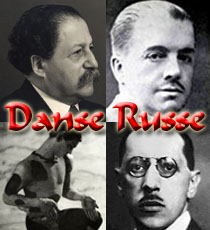 Paul Moravec and I are now at work on our second opera–but don’t call it that!
Paul Moravec and I are now at work on our second opera–but don’t call it that!
The Philadelphia International Festival of the Arts, which gets underway on April 1, 2011, is a citywide venture that will encompass the premieres of thirty-one works intended to capture “the inventive, no-holds-barred spirit of Paris: 1910-1920, the inspiration and theme of the 25-day festival.” Center City Opera Theater is contributing to the festivities with a program that will pair Renard, a rarely produced one-act chamber opera composed in 1916 by Igor Stravinsky, with a new work written for the same performing forces as Renard, four male singers (two tenors, a baritone, and a bass-baritone) and a small instrumental ensemble.
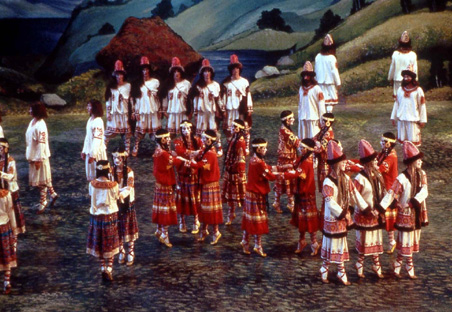 Andrew Kurtz, who runs Center City Opera, invited Paul and me to write a companion piece to Renard. I came up with the idea of a backstage farce about the creation of Stravinsky’s Rite of Spring. The title is Danse Russe. The four characters, whose real-life models are pictured above, are:
Andrew Kurtz, who runs Center City Opera, invited Paul and me to write a companion piece to Renard. I came up with the idea of a backstage farce about the creation of Stravinsky’s Rite of Spring. The title is Danse Russe. The four characters, whose real-life models are pictured above, are:
• Sergei Diaghilev, the founder of the Ballets Russes, who commissioned The Rite of Spring
• Vaslav Nijinsky, Diaghilev’s lover and star dancer, who choreographed the ballet
• Pierre Monteux, who conducted the first performance
• Stravinsky himself
Unlike The Letter, our previous collaboration, Danse Russe is a knockabout comedy with spoken dialogue. We’re calling it a “vaudeville,” and we expect it to play more like a musical than an opera. I finished the first draft of the libretto three weeks ago, and Paul started writing the music last week.
We open in Philadelphia on April 15–and yes, I’ll be blogging with steadily increasing frequency about the making of Danse Russe between now and then.
More as it happens.
CAAF: Your ex-girlfriend gives it one year, tops
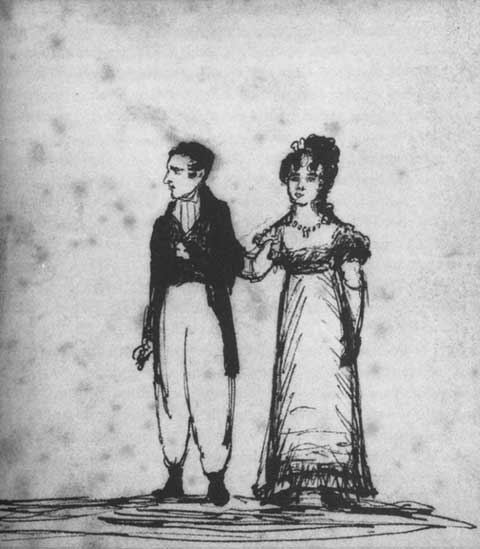
I’m amused by this pen and ink sketch of Lord and Lady Byron shortly after their marriage. It was drawn by Lady Caroline Lamb, who had carried on an affair with the poet before being thrown over a few years before (it was Lamb who called Bryon “mad, bad and dangerous to know”). As with the couple’s correspondence about religion, it’s an early signal that the marriage was headed for a spectacular flame-out. Lamb was hardly objective of course, but look at that body language!
The sketches Lamb kept in her journals have real wit and charm. But the novel she later wrote about Byron, Glenarvon, is wonderfully terrible. I’m reading it right now and it’s like slogging through a juvenile Bronte effort with all the trotting around moonlit ruins and character names like Calantha, the Duchess of Altamonte and Sir Everard St. Clare. Sample:
At this very period of time, in the prosecution of her sudden and accursed designs, having bade adieu to brighter climes and more polished manners, with all the gaiety of apparent innocence, and all the brilliancy of wit which belongs to spirits light as air and a refined and highly cultivated genius, she was sailing, accompanied by a train of admirers, selected from the flower of Italy, once again to visit her native country.
That does sound fancy, doesn’t it? And evil. I wish Lamb had done the book as a graphic novel instead.
(Sketch scanned from Fiona MacCarthy’s very good Bryon: Life and Legend.)
TT: Almanac
“A man’s hope measures his civilization.”
Ezra Pound, Guide to Kulchur
TT: Perpetual motion
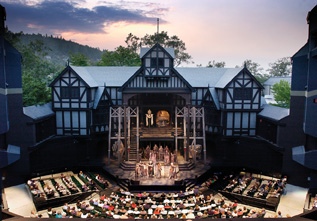 The summer has started in earnest, and Mrs. T and I depart the East Coast yet again today. This time we’ll be en route to the Oregon Shakespeare Festival, I for the third time, she for the first. We’ll be seeing four shows during our week-long stay, and you’ll read about them in my Wall Street Journal drama column, where I’ll be reviewing the festival for two weeks running.
The summer has started in earnest, and Mrs. T and I depart the East Coast yet again today. This time we’ll be en route to the Oregon Shakespeare Festival, I for the third time, she for the first. We’ll be seeing four shows during our week-long stay, and you’ll read about them in my Wall Street Journal drama column, where I’ll be reviewing the festival for two weeks running.
I expect we’ll find time to do some other things as well, and you’ll get to read about those in this space sooner or later. Don’t ask which, though!
TT: Not for gazillionaires only
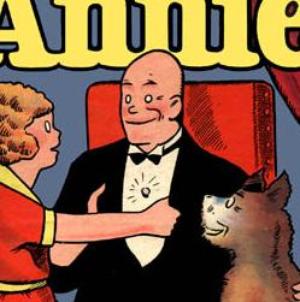 Pops: A Life of Louis Armstrong has turned up on a fair number of best-of lists since it came out late last year, but the latest of these appearances is undoubtedly the one that tickles me most. J.P. Morgan Private Bank, which caters to individuals of “ultra high net worth,” distributes a summer reading list to its billionaire clients–and Pops, to my jaw-dropping astonishment, made this year’s list.
Pops: A Life of Louis Armstrong has turned up on a fair number of best-of lists since it came out late last year, but the latest of these appearances is undoubtedly the one that tickles me most. J.P. Morgan Private Bank, which caters to individuals of “ultra high net worth,” distributes a summer reading list to its billionaire clients–and Pops, to my jaw-dropping astonishment, made this year’s list.
Says J.P. Morgan’s Web site:
Since its inception, the J.P. Morgan Summer Reading List has been designed to resonate with the diverse passions of our clients across the globe. As the list marks its second decade, we have once again created a collection of 10 nonfiction titles from among the 450 nominated by our offices worldwide–a selection that taps into today’s compelling issues, personalities and cultural highlights. Whether you seek insightful biographies, chronicles of companies transforming our lives, an up-close look at the financial crisis, or artful works to pique your senses, we think our recommendations will intrigue you. Enjoy.
To see the entire list, go here.
Oh, yes–I accept cash.
TT: Almanac
“Hope is a good breakfast, but it is a bad supper.”
Francis Bacon, Apophthegms
THE ZERO OPTION
“What, if anything, justifies the existence of a regional symphony orchestra in the 21st century? Many people still believe that an orchestra is a self-evidently essential part of what makes a city civilized. But is this true?…”
